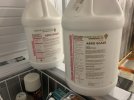MajorTurbulence
Line Up and Wait
- Joined
- Jan 9, 2013
- Messages
- 715
- Display Name
Display name:
MajorTurbulence
This has probably been asked before so apologies. But I’m interested in tips for paint restoration. My paint job is about 14 yrs old and still looks good from a distance, but has much of the surfaces exposed to to light and uv with oxidation as the plane has been tied down outside. There has been a canopy cover used all the time so the discrepancy can be seen compared to areas uncovered by that canopy cover. The left side of the plane is exposed to continuously southern sun exposure. There are only a few areas where paint has flaked off on the rear wing area, but otherwise paint is still respectable. I should note that a quality paint from DuPont was used, but probably not Imron.
After the first few years, I was gung-ho regarding cleaning and waxing, but really not much done since to the outside paint except for washing at annual.
So, what are the the best methods to rejuvenate and protect what is there. Not very familiar with cleaners/solutions except for the usual automotive cleaning soaps and waxes and abrasive compounds.
Intrigued about ceramic coatings but may not be appropriate for this setting.
I bought a DA polisher from Harbor Freight to attempt a facelift of my classic corvette, but really, I don’t know how to use it yet without doing damage.
After the first few years, I was gung-ho regarding cleaning and waxing, but really not much done since to the outside paint except for washing at annual.
So, what are the the best methods to rejuvenate and protect what is there. Not very familiar with cleaners/solutions except for the usual automotive cleaning soaps and waxes and abrasive compounds.
Intrigued about ceramic coatings but may not be appropriate for this setting.
I bought a DA polisher from Harbor Freight to attempt a facelift of my classic corvette, but really, I don’t know how to use it yet without doing damage.
Last edited:


